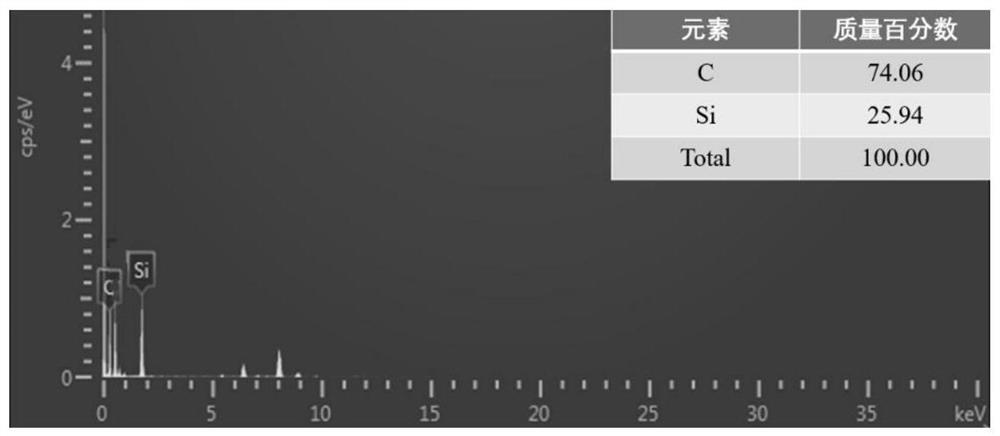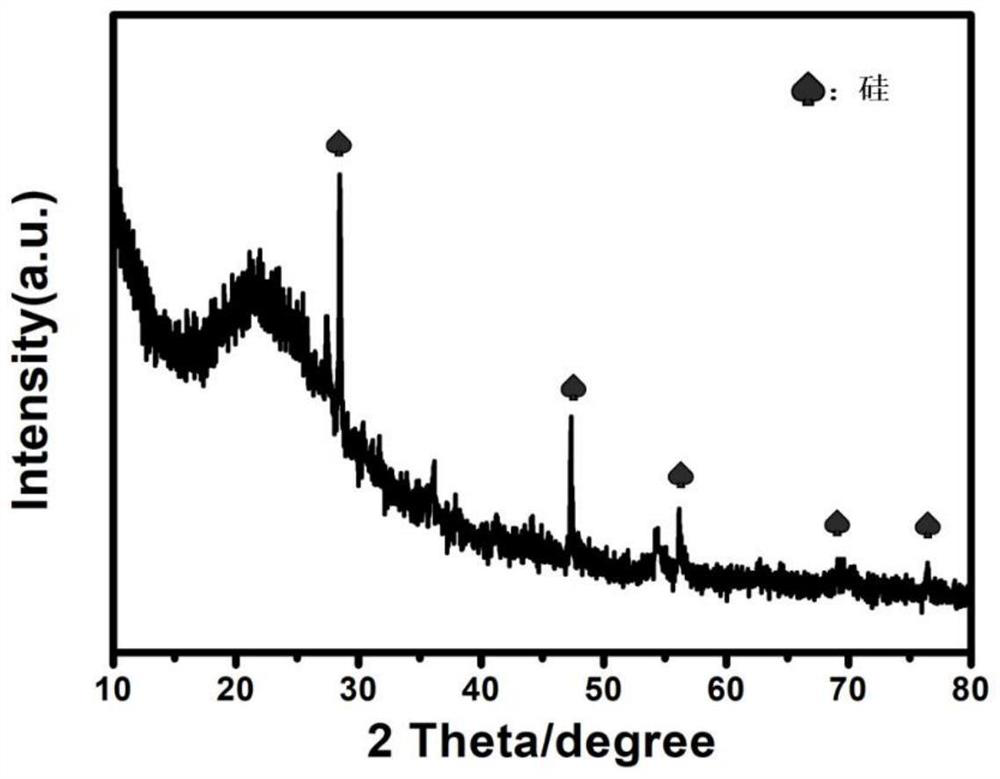Nanometer sheet-shaped silicon-carbon composite material used as lithium ion battery negative electrode material and preparation method of nanometer sheet-shaped silicon-carbon composite material
A technology of silicon-carbon composite materials and lithium-ion batteries, applied in nanotechnology for materials and surface science, battery electrodes, carbon preparation/purification, etc., can solve problems such as few reports on nano-silicon/carbon composite materials, Achieve the effect of improving charge transfer efficiency, controllable conditions, and improving performance
- Summary
- Abstract
- Description
- Claims
- Application Information
AI Technical Summary
Problems solved by technology
Method used
Image
Examples
Embodiment 1
[0036] In this embodiment, nano-sheet silicon-carbon composites are prepared according to the following steps:
[0037] (1) Preparation of precursor powder
[0038] Weigh 0.5 g of vinyl cage octahedral silsesquioxane, 4.5 g of lithium chloride and 5.5 g of potassium chloride and grind them in a mortar for 10 min, and mix the ground powder in a ball mill at 500 rpm for 2 h. The ball-milled mixture was dried at 70° C. for 4 h to obtain the precursor powder.
[0039] (2) High temperature magnesia thermal reduction
[0040] Put the precursor powder on one end of the stainless steel burning boat, add 0.5g magnesium powder to the other end, and transfer the burning boat to the tube furnace. Then, the temperature was raised to 400° C. at a rate of 5° C. / min under argon gas, kept for 4 hours, and cooled to room temperature naturally.
[0041] (3) washing and drying to obtain composite materials
[0042] Put 10 g of the reaction product of step (2) in a beaker, add 500 mL of deioni...
Embodiment 2
[0048] In this embodiment, nano-sheet silicon-carbon composites are prepared according to the following steps:
[0049] (1) Preparation of precursor powder
[0050] Weigh 0.5 g of phenyl cage octahedral silsesquioxane, 4.5 g of lithium chloride and 5.5 g of potassium chloride and grind them in a mortar for 10 min, and mix the ground powder in a ball mill at 500 rpm for 2 h. The ball-milled mixture was dried at 70° C. for 4 h to obtain the precursor powder.
[0051] (2) High temperature magnesia thermal reduction
[0052] Put the precursor powder on one end of the stainless steel burning boat, add 0.5g magnesium powder to the other end, and transfer the burning boat to the tube furnace. Then, the temperature was raised to 300° C. under argon at a heating rate of 5° C. / min, kept for 4 hours, and cooled to room temperature naturally.
[0053] (3) washing and drying to obtain composite materials
[0054] Put 10 g of the reaction product of step (2) in a beaker, add 500 mL of d...
Embodiment 3
[0059] In this embodiment, nano-sheet silicon-carbon composites are prepared according to the following steps:
[0060] (1) Preparation of precursor powder
[0061] Weigh 0.5 g of vinyl cage octahedral silsesquioxane, 4.5 g of lithium chloride and 5.5 g of potassium chloride and grind them in a mortar for 10 min, and mix the ground powder in a ball mill at 500 rpm for 2 h. The ball-milled mixture was dried at 70° C. for 4 h to obtain the precursor powder.
[0062] (2) High temperature magnesia thermal reduction
[0063] Put the precursor powder on one end of the stainless steel burning boat, add 0.5g magnesium powder to the other end, and transfer the burning boat to the tube furnace. Then, the temperature was raised to 300° C. under argon at a heating rate of 5° C. / min, kept for 4 hours, and cooled to room temperature naturally.
[0064] (3) washing and drying to obtain composite materials
[0065] Put 10 g of the reaction product of step (2) in a beaker, add 500 mL of de...
PUM
| Property | Measurement | Unit |
|---|---|---|
| diameter | aaaaa | aaaaa |
Abstract
Description
Claims
Application Information
 Login to View More
Login to View More - R&D
- Intellectual Property
- Life Sciences
- Materials
- Tech Scout
- Unparalleled Data Quality
- Higher Quality Content
- 60% Fewer Hallucinations
Browse by: Latest US Patents, China's latest patents, Technical Efficacy Thesaurus, Application Domain, Technology Topic, Popular Technical Reports.
© 2025 PatSnap. All rights reserved.Legal|Privacy policy|Modern Slavery Act Transparency Statement|Sitemap|About US| Contact US: help@patsnap.com



